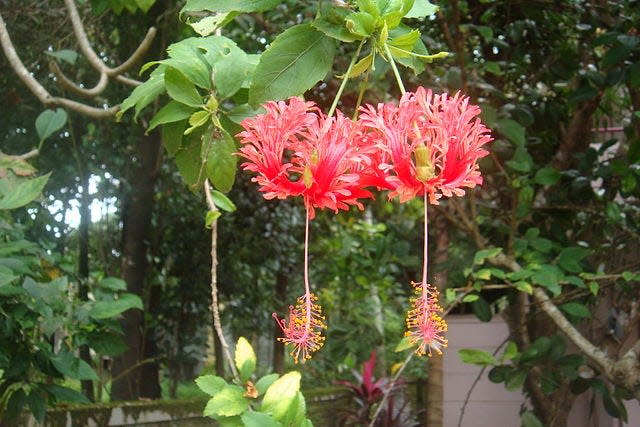CHARLES REYNOLDS: Fringed hibiscus most graceful of all

Two of my favorite plants are wholly different from each other, except for one thing: they display parachute-like blossoms. One of the plants is Rothschild’s lily, a tuberous, seasonally dormant, herbaceous vine; the other is fringed hibiscus (H. schizopetalus). Also known as parasol hibiscus and Japanese lantern flower, this East African shrub grows up to 12 feet tall on well-drained, fertile sites that are kept mulched. I saw my first fringed hibiscus at Cypress Gardens in the mid '70s and have loved the species ever since.
The petals of its red or pink dangling blossoms are remarkably frilly. Supporting the parachute impression are the blossoms’ stamens, suspended on lengthy, colorful columns and evoking daring skydivers. Fringed hibiscus — long used by plant breeders to add grace to Hibiscus hybrids — is as cold hardy as most hibiscus shrubs. Locations shielded from north and northwest winds are best. Plants, usually available online, are propagated with warm-season cuttings.
Play the Melody
Folks have been cultivating spinach — thought to be Asian in origin — for at least 800 years. Melody spinach has been around only since the late '70s and is one of the best hybrids ever developed. Melody grows very fast and is disease resistant. It’s also slow to bolt (go to seed) as warm weather approaches. With its crinkled foliage, Melody is considered a ‘’savoy-leaved’’ spinach. Some folks prefer smooth-leaved types because they’re easier to clean when harvested. If you’re a diehard seed saver, don’t bother with Melody or other hybrids because their seeds don’t breed true. Another tried-and-tested spinach for Central Florida is Virginia Savoy. Seeds can be sown through November. Space them every 4 inches in rows set 18 inches apart.
Friendly fungi
Thousands of species of Mycorrhizal fungi grow underground worldwide, vastly improving plants’ ability to utilize water and nutrients. How important are these fungi? Well, hydroponic growers routinely inoculate their plants with liquid or powdered Mycorrhizae. The name comes from ‘’myco,’’ which means fungus, and ‘’rhizo,’’ which refers to roots. But climate change may be affecting some of these fungi (which have been around for 500 million years), in turn threatening the health of forests and woodlands. Various Mycorrhizal inoculants are available online but are probably unnecessary for Florida’s landscape and containerized plants. Adding those inoculants won’t injure plants, however.
Plenty of nectar plants in most gardens
A remarkable number of butterfly nectar plants populate most landscapes. They include woody species such as hibiscus, firebush, azalea, ixora, plumbago, dwarf poinciana, chaste tree, jatropha, bougainvillea, coral honeysuckle, confederate jessamine, Florida heather and lantana. Among herbaceous nectar sources are pentas, firecracker plant, black-eyed Susan, Mexican bluebell, tropical sage, porterweed, red shrimp plant, Stokes’ aster and society garlic. If you’re not seeing many butterflies, the problem may be your pesticide usage, not the plants. Most chemicals are deadly to these beautiful insects.
This article originally appeared on The Ledger: Fringed hibiscus displays parachute-like blossoms

